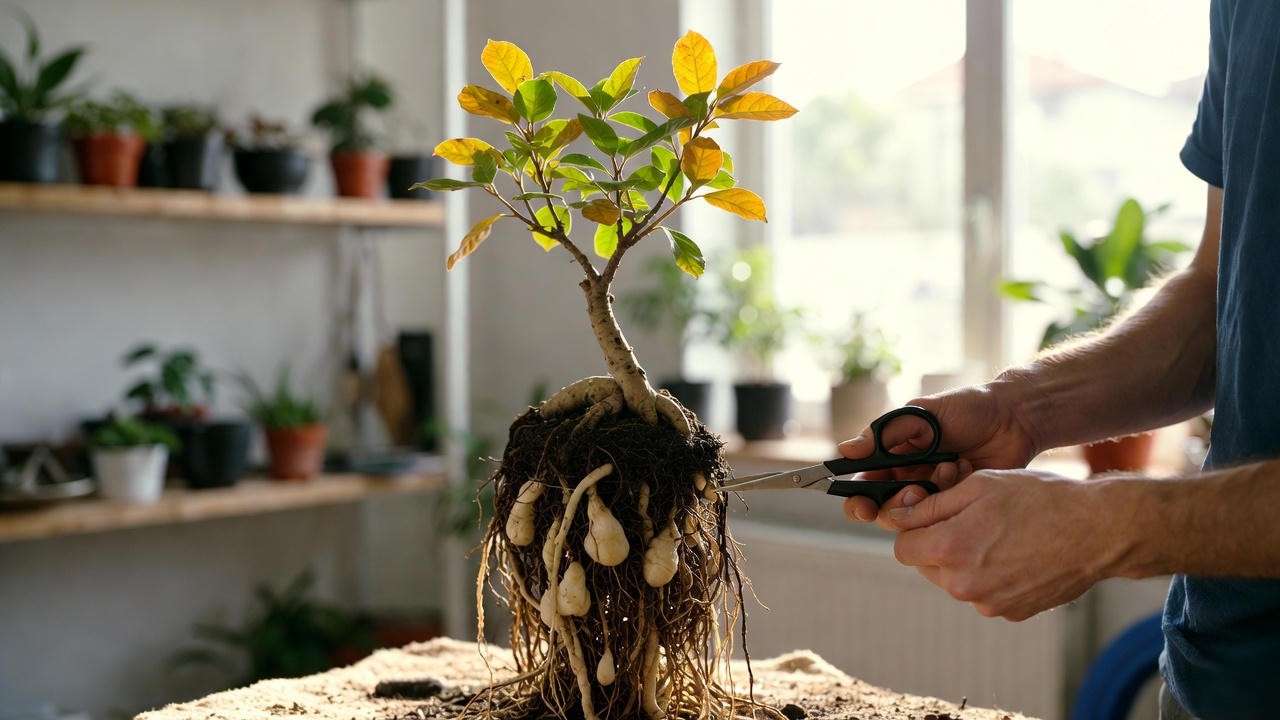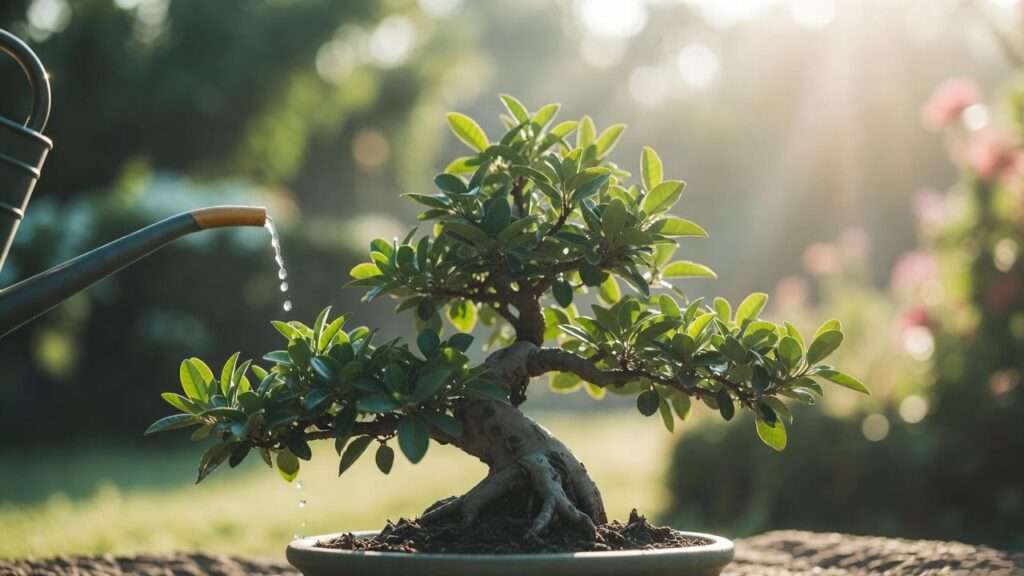Picture this: your bonsai tree, a tiny masterpiece sculpted by nature, stands proudly with vibrant leaves and sturdy roots, captivating everyone who sees it. Now imagine it wilting, its leaves yellowing, all because of one critical mistake—improper watering. Bonsai tree watering is the heartbeat of caring for these delicate, living artworks, yet it’s where most enthusiasts stumble. Whether you’re a beginner or a seasoned grower, mastering the art of hydration can transform your bonsai from struggling to thriving. In this guide, backed by 15 years of bonsai cultivation experience and insights from certified arborists, we’ll unlock the secrets to watering your bonsai like a pro, ensuring it flourishes for years to come. 🌿
Why Bonsai Tree Watering Is So Critical 🌳
The Unique Needs of Bonsai Trees
Bonsai trees aren’t just miniature versions of their full-sized cousins—they’re intricate ecosystems confined to shallow pots. This unique setup makes bonsai tree watering a delicate balance. Unlike typical houseplants, bonsais have limited soil to retain moisture, and their roots are more exposed to environmental changes. Proper hydration supports photosynthesis, nutrient uptake, and overall vitality. Get it wrong, and your bonsai could face stunted growth or, worse, root rot.
Expert Insight: “Watering is the most critical skill in bonsai care,” says Hiroshi Tanaka, a third-generation bonsai master from Kyoto. “It’s not about how much water you give, but how well you understand your tree’s needs.”

Common Watering Mistakes to Avoid 🚫
Watering mistakes are the leading cause of bonsai decline. Here are the big ones to steer clear of:
- Overwatering: Excess water suffocates roots, leading to rot. Signs include soggy soil and a musty smell.
- Underwatering: Too little water starves the tree, causing wilting or brittle leaves.
- Inconsistent Schedules: Bonsais thrive on routine, and erratic watering disrupts their rhythm.
Tip: Invest in a moisture meter (around $10–$20) to take the guesswork out of watering, especially if you’re new to bonsai care.
Understanding Your Bonsai’s Watering Needs 💦
Factors That Influence Watering Frequency
No two bonsais are alike, and their watering needs vary based on several factors:
- Species: Tropical bonsais like Ficus or Jade require more frequent watering than temperate ones like Juniper or Pine, which tolerate brief dry spells.
- Pot Size and Soil Type: Smaller pots and gritty, fast-draining soils (common in bonsai) dry out quickly.
- Environment: Indoor bonsais face low humidity, while outdoor ones contend with rain, wind, or heat. Seasonal shifts also play a role—summer demands more water, winter less.
Example: A Ficus bonsai indoors in a dry, heated room may need watering every 2–3 days, while an outdoor Pine in a temperate climate might go 5–7 days in cooler months.
How to “Read” Your Bonsai’s Signals 📖
Your bonsai communicates its needs if you know where to look. Check these cues:
- Leaves: Drooping or yellowing leaves often signal overwatering; dry, brittle leaves suggest underwatering.
- Soil: Insert a chopstick 1–2 inches into the soil. If it comes out dry, it’s time to water. If damp, wait a day.
- Weight: Lift the pot—light pots indicate dry soil; heavy ones suggest moisture.
Pro Tip: Keep a bonsai journal to track watering patterns and your tree’s responses. This helps you fine-tune your routine over time.
Step-by-Step Guide to Perfect Bonsai Tree Watering 🌧️
Step 1: Choose the Right Tools
The right tools make bonsai tree watering precise and effective:
- Watering Can: Use one with a fine rose nozzle for a gentle, even flow that mimics natural rain.
- Spray Bottle: Ideal for misting foliage, especially for tropical species like Ficus or Serissa.
- Moisture Meter: A budget-friendly gadget to measure soil moisture accurately.
Step 2: Watering Techniques for Success
Here are the top methods to hydrate your bonsai:
- Top Watering: Pour water slowly over the soil until it drains from the pot’s bottom holes. This ensures even moisture distribution. Repeat if the soil is very dry.
- Immersion Method: Submerge the entire pot in a basin of water for 5–10 minutes. This is perfect for severely dry soil but use sparingly to avoid over-saturation.
- Misting: Lightly spray the foliage to boost humidity, especially for indoor bonsais in dry climates.
Example: To water a Juniper bonsai in summer, use top watering in the early morning. Pour slowly for 30–60 seconds, ensuring water drains freely. Mist the needles lightly if humidity is low.

Step 3: Timing and Frequency
Timing is everything in bonsai care:
- Best Time: Water early in the morning to mimic natural dew and allow foliage to dry before night.
- Frequency: Check soil daily, but only water when the top ¼ inch feels dry. This could mean every 2–7 days, depending on your bonsai’s needs.
- Seasonal Adjustments: In summer, water more frequently due to heat and growth. In winter, reduce watering as growth slows.
Chart Idea: A seasonal watering calendar could show:
- Spring: Water every 3–5 days.
- Summer: Every 1–3 days.
- Fall: Every 4–6 days.
- Winter: Every 7–10 days (for dormant species).
Step 4: Ensure Proper Drainage
Good drainage is non-negotiable. Bonsai pots must have drainage holes, and the soil should be a well-draining mix (e.g., akadama, pumice, and lava rock). Poor drainage traps water, leading to root rot. To check drainage:
- After watering, ensure water flows freely from the bottom.
- If water pools or drains slowly, repot with a fresh, gritty soil mix.
DIY Tip: Mix your own bonsai soil with 50% akadama, 25% pumice, and 25% lava rock for optimal drainage and aeration.
Advanced Bonsai Watering Tips for Long-Term Health 🌟
Tailoring Watering to Your Bonsai’s Life Stage
Bonsais evolve, and so should your watering approach:
- Young Bonsais: Need consistent moisture to support root and branch development. Water when the topsoil is slightly dry.
- Mature Bonsais: Require balanced hydration to maintain their structure. Allow the soil to dry slightly more between waterings to encourage resilience.
Case Study: A 20-year-old Chinese Elm bonsai was revived after years of overwatering. By switching to a well-draining soil mix and watering only when the top inch of soil was dry, the tree regained its vibrant foliage within six months.
Water Quality Matters
The water you use can make or break your bonsai’s health:
- Rainwater: Ideal, as it’s free of chlorine and minerals. Collect it in a clean bucket during storms.
- Filtered Water: A good alternative if rainwater isn’t available. Avoid tap water, which often contains chlorine or hard minerals that build up in soil.
- pH Levels: Aim for slightly acidic water (pH 6.0–6.5) to match bonsai soil preferences.
Expert Insight: A 2019 study from the University of Tokyo found that tap water with high chlorine levels reduced root vitality in bonsai trees by 15% over two years.

Adapting to Environmental Changes
Your bonsai’s environment shapes its watering needs:
- Indoor Bonsais: Combat dry air from heaters or AC with humidity trays (a shallow tray with pebbles and water) or a room humidifier.
- Outdoor Bonsais: Protect from heavy rain with a rain cover or move under shelter. During droughts, increase watering frequency.
Pro Tip: For outdoor bonsais in monsoon season, use a breathable rain cover to prevent soil from becoming waterlogged.
Troubleshooting Bonsai Watering Problems 🛠️
Signs of Overwatering and How to Fix It
Overwatering is a common pitfall that can devastate your bonsai. Look for these red flags:
- Yellowing Leaves: A sign of waterlogged roots struggling to breathe.
- Mushy Roots: Check the roots by gently lifting the tree from its pot—if they’re soft or black, root rot has set in.
- Foul-Smelling Soil: A musty odor indicates fungal growth from excess moisture.
Solutions:
- Stop watering immediately and let the soil dry out for a few days.
- If root rot is present, repot the bonsai. Trim away damaged roots with sterilized scissors and use a fresh, well-draining soil mix.
- Adjust your watering routine—check soil moisture before watering and ensure proper drainage.
Tip: After repotting, place the bonsai in a shaded area for 1–2 weeks to reduce stress while it recovers.

Signs of Underwatering and Recovery Steps
Underwatering starves your bonsai, but timely action can save it. Watch for:
- Brittle Leaves: Leaves that feel dry or crispy indicate severe dehydration.
- Shrinking Soil: Soil pulling away from the pot’s edges shows extreme dryness.
- Slow Growth: A lack of new shoots or buds suggests insufficient water.
Solutions:
- Gradually rehydrate by soaking the pot in a basin of water for 10–15 minutes. Avoid flooding the soil all at once, as this can shock the roots.
- Mist the foliage daily for a week to boost humidity and support recovery.
- Establish a consistent watering schedule, checking soil daily until the tree stabilizes.
Pro Tip: If your bonsai is severely dehydrated, add a few drops of liquid seaweed fertilizer to the water to encourage root regrowth.
When to Seek Expert Help
If watering adjustments don’t resolve persistent issues, deeper problems like pests, disease, or improper potting may be at play. Consider these steps:
- Join a local bonsai club or online forum (e.g., Bonsai Empire or Reddit’s r/Bonsai) for community advice.
- Consult a professional arborist or bonsai specialist for a hands-on diagnosis.
- Use resources like the American Bonsai Society’s website for expert guidance.
Example: A grower in California saved a struggling Ficus bonsai by consulting a local bonsai nursery, which identified a hidden pest issue exacerbated by overwatering.
FAQs About Bonsai Tree Watering ❓
To address common queries and boost SEO, here are answers to frequently asked questions about bonsai tree watering:
Q1: How often should I water my bonsai tree? A: It depends on the species, pot size, soil type, and environment. Check the soil daily—water when the top ¼ inch feels dry. For example, a tropical Ficus may need water every 2–3 days, while a Juniper might go 5–7 days in cooler weather.
Q2: Can I use tap water for my bonsai? A: Tap water isn’t ideal due to chlorine and mineral content, which can harm roots over time. Use rainwater or filtered water for best results. If tap water is your only option, let it sit for 24 hours to allow chlorine to dissipate.
Q3: Is misting enough to water my bonsai? A: No, misting boosts humidity but doesn’t provide enough moisture to the roots. Use it as a supplement for tropical bonsais or in dry indoor settings, alongside thorough watering.
Q4: What’s the best watering method for beginners? A: Top watering with a fine-nozzle watering can is the easiest and most effective method. Pour slowly until water drains from the bottom, ensuring even hydration.
Conclusion: Your Path to Bonsai Watering Mastery 🌿
Mastering bonsai tree watering is both an art and a science, blending careful observation, precise techniques, and a deep connection to your tree’s needs. By understanding your bonsai’s unique requirements, using the right tools, and avoiding common mistakes, you can keep your miniature masterpiece thriving for decades. Start today: check your bonsai’s soil, refine your watering routine, and watch it flourish with vibrant health. Have a watering tip or question? Share it in the comments below—we’d love to hear from you! 🌟
For further learning, explore trusted resources like Bonsai Empire or the American Bonsai Society to deepen your bonsai care expertise.













